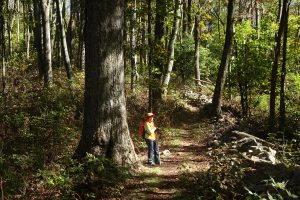15-18 Oct: After passing through Nashville, where it looked like a major construction boom was underway, we traveled into northeastern Tennessee, entering the hilly western slope of the Appalachian Mountains. We spent one day in Knoxville, another day biking in Kingsport and moving farther east, and a third day hiking in the Appalachians.
American hunters and settlers began moving across the crest of the Appalachians into the Tennessee Valley in increasing numbers after the Revolutionary War. In 1783, land speculator William Blount convinced his state of North Carolina to open up the area for settlement and offer land for sale there. A year later, residents organized the so-called State of Franklin, although it was never recognized by the federal government. In 1789, Blount, then a member of the N.C. state legislature, promoted ratification of the U.S. Constitution and was one of its signers. The following year, President Washington appointed Blount as first governor of the newly formed Southwest Territory (south of the Ohio River and west of the Appalachian Mountains). Knoxville became the territorial capital. There we toured the Blount Mansion, said to be the first frame house built west of the Alleghenies. Construction began in 1792 and the house was indeed a mansion by comparison with other settlers’ log houses with their dirt floors. Blount’s house was built from sawn lumber and had glass windows (“the house with many eyes”). William Blount was so successful in promoting settlement in the Tennessee Valley that the population quickly surpassed the minimum number required for statehood. In 1796, Tennessee became the 16th state, with Knoxville as its first capital. In 1797, however, Blount’s national reputation was ruined as a U.S. Senator from Tennessee when he was impeached by the U.S. House for his part in the “Blount Conspiracy,” a plan to enlist the aid of the British Navy and territorial militias to attack Spanish possessions in North America, hoping to keep Mississippi ports open to American commerce.


Kingston, a short way south of the Virginia border, is on the Holston River, a major tributary of the Tennessee River. We rode on the Kingston Greenway, along the South Fork of the Holston and one of its tributaries, Reedy Creek. Much of this paved bicycle path is beside the river and creek banks, in quiet and shady woods. Historical signs and buildings beside the trail imparted a sense of this as an important transportation corridor in the late 1700s and early 1800s. This was the head of navigation of the entire Tennessee River system. Flatboats built here transported freight and passengers to ports such as Knoxville, Huntsville, St. Louis, Natchez, and New Orleans. Daniel Boone blazed the Wilderness Road from here into Kentucky through the Cumberland Gap, and Kingsport served as a staging area for pioneers traveling that road.

Our third Tennessee campground was in the Cherokee National Forest on the eastern shore of an impoundment on the South Fork of the Holston River, upriver from Kingsport and close to the Appalachian Trail. We hiked a few miles along the AT and back again on a beautiful fall day. This section of trail follows a ridge top through a pleasant forest, mostly of hardwoods. Although deeply wooded now, a substantial stone wall we hiked along for a while was a tangible reminder that this path was once a wagon road past cleared fields of settlers eking out a living in the 1800s. We passed the concrete footings that once supported a fire lookout tower, a rustic lean-to, and a couple of end-to-end backpackers from Maine on their way to Georgia.



